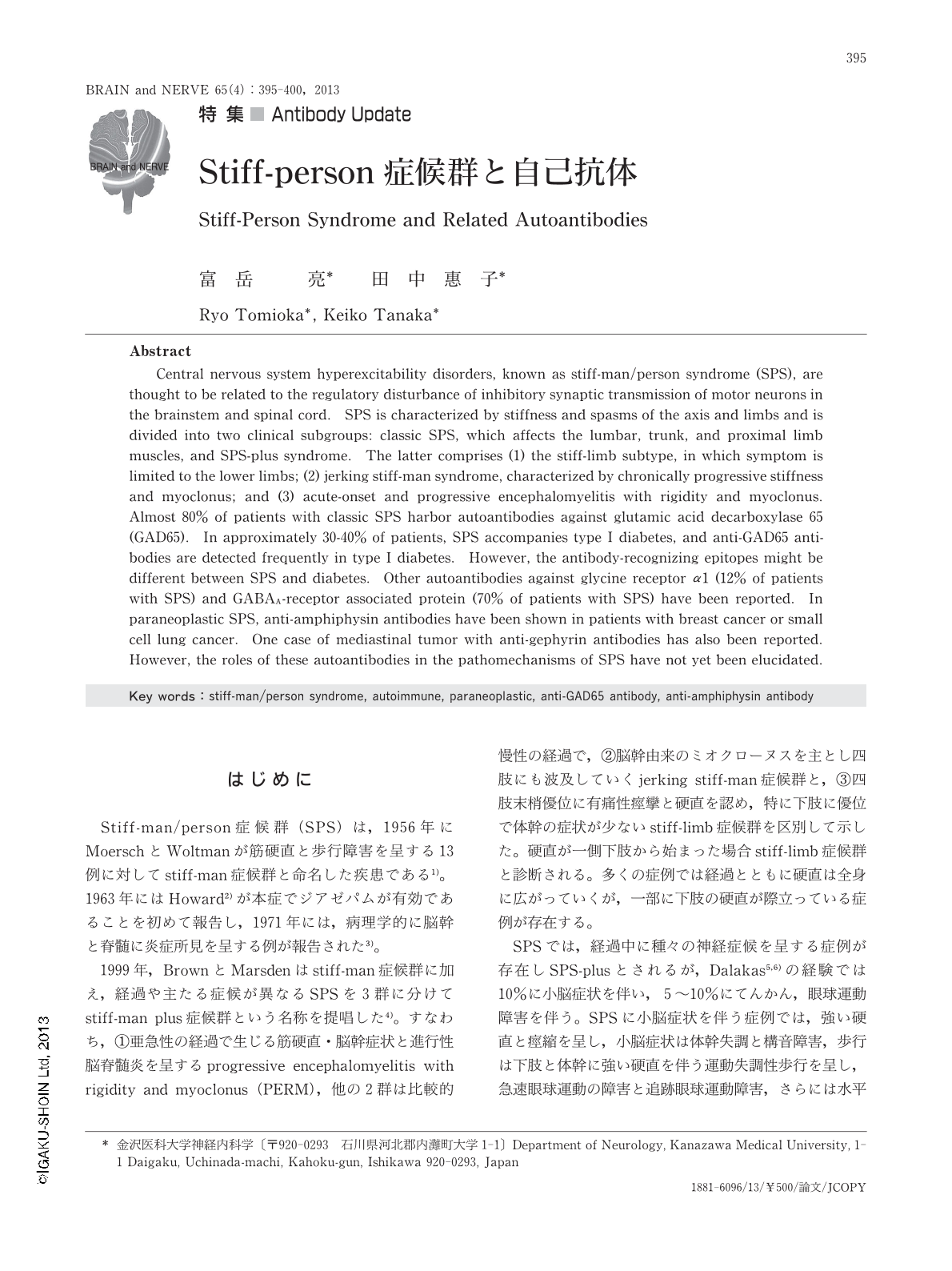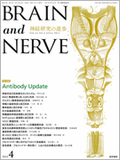Japanese
English
- 有料閲覧
- Abstract 文献概要
- 1ページ目 Look Inside
- 参考文献 Reference
はじめに
Stiff-man/person症候群(SPS)は,1956年にMoerschとWoltmanが筋硬直と歩行障害を呈する13例に対してstiff-man症候群と命名した疾患である1)。1963年にはHoward2)が本症でジアゼパムが有効であることを初めて報告し,1971年には,病理学的に脳幹と脊髄に炎症所見を呈する例が報告された3)。
1999年,BrownとMarsdenはstiff-man症候群に加え,経過や主たる症候が異なるSPSを3群に分けてstiff-man plus症候群という名称を提唱した4)。すなわち,①亜急性の経過で生じる筋硬直・脳幹症状と進行性脳脊髄炎を呈するprogressive encephalomyelitis with rigidity and myoclonus(PERM),他の2群は比較的慢性の経過で,②脳幹由来のミオクローヌスを主とし四肢にも波及していくjerking stiff-man症候群と,③四肢末梢優位に有痛性痙攣と硬直を認め,特に下肢に優位で体幹の症状が少ないstiff-limb症候群を区別して示した。硬直が一側下肢から始まった場合stiff-limb症候群と診断される。多くの症例では経過とともに硬直は全身に広がっていくが,一部に下肢の硬直が際立っている症例が存在する。
SPSでは,経過中に種々の神経症候を呈する症例が存在しSPS-plusとされるが,Dalakas5,6)の経験では10%に小脳症状を伴い,5~10%にてんかん,眼球運動障害を伴う。SPSに小脳症状を伴う症例では,強い硬直と痙縮を呈し,小脳症状は体幹失調と構音障害,歩行は下肢と体幹に強い硬直を伴う運動失調性歩行を呈し,急速眼球運動の障害と追跡眼球運動障害,さらには水平注視時の眼振を認めた。以上のように,SPSは古典的なstiff-man症候群に加え,stiff-man plus症候群,さらに傍腫瘍症候群としてのSPSが加わり徐々に本症候群の概念が確立されていった。
本症では神経組織に炎症所見を生じる例があることから,ステロイドホルモン投与7),血漿交換療法が試行され8),奏効する例が報告されたことより,自己免疫学的機序の可能性について検討が加えられた。Solimena, De Camilliら9,10)はSPSの約60%にグルタミン酸脱炭酸酵素(glutamate decarboxylase:GAD)に対する自己抗体の存在を見出した。また,悪性腫瘍を背景とし,SPSを呈する傍腫瘍性神経症候群で抗アンフィフィシン(amphiphysin)I抗体が検出された例が報告され11),縦隔腫瘍にSPSを合併した1例でゲフィリン(gephyrin)抗体が見出されたとの報告もある12)。
Abstract
Central nervous system hyperexcitability disorders, known as stiff-man/person syndrome (SPS), are thought to be related to the regulatory disturbance of inhibitory synaptic transmission of motor neurons in the brainstem and spinal cord. SPS is characterized by stiffness and spasms of the axis and limbs and is divided into two clinical subgroups: classic SPS, which affects the lumbar, trunk, and proximal limb muscles, and SPS-plus syndrome. The latter comprises (1) the stiff-limb subtype, in which symptom is limited to the lower limbs; (2) jerking stiff-man syndrome, characterized by chronically progressive stiffness and myoclonus; and (3) acute-onset and progressive encephalomyelitis with rigidity and myoclonus. Almost 80% of patients with classic SPS harbor autoantibodies against glutamic acid decarboxylase 65 (GAD65). In approximately 30-40% of patients, SPS accompanies type I diabetes, and anti-GAD65 antibodies are detected frequently in type I diabetes. However, the antibody-recognizing epitopes might be different between SPS and diabetes. Other autoantibodies against glycine receptor α1 (12% of patients with SPS) and GABAA-receptor associated protein (70% of patients with SPS) have been reported. In paraneoplastic SPS, anti-amphiphysin antibodies have been shown in patients with breast cancer or small cell lung cancer. One case of mediastinal tumor with anti-gephyrin antibodies has also been reported. However, the roles of these autoantibodies in the pathomechanisms of SPS have not yet been elucidated.

Copyright © 2013, Igaku-Shoin Ltd. All rights reserved.


